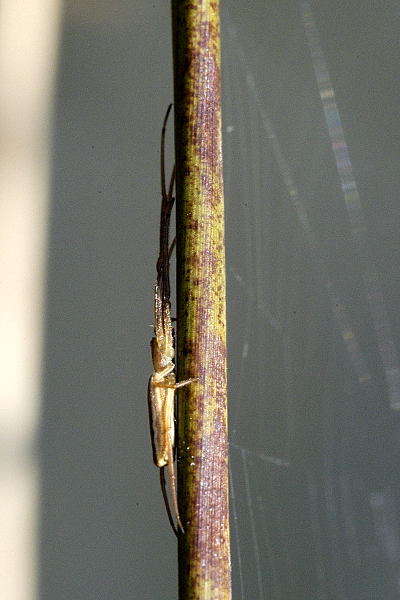We were sitting on a pond dock when someone spotted this creature stretched flat along a pole above the water. Its slender length was dramatic enough that at first glance we weren't sure what kind of insect it was, but after counting its 8 legs we clinched the diagnosis as a spider.
Its posture and the jaws extending way in front of its head is a dead giveaway to its identification. This is a Long-jawed Orb Weaver (LJO) of the family Tetragnatha (four jaws in Greek). There are over 1,000 species found world wide, especially in the tropics, but only around 15 species in the US. Identification of the species requires a specialist with lots of magnification to see parts that you and I could not identify.
 Also called "stretch spiders", LGOs extend their legs when threatened to
hide on a blade of grass. With their long legs and light weight body
they are able to run on the surface of the water like a water strider.
The third pair of legs which are much shorter are
used to cling to grass or other vegetation as they stretch their other
longer legs out in front and behind, blending in to the leaf blade.
Also called "stretch spiders", LGOs extend their legs when threatened to
hide on a blade of grass. With their long legs and light weight body
they are able to run on the surface of the water like a water strider.
The third pair of legs which are much shorter are
used to cling to grass or other vegetation as they stretch their other
longer legs out in front and behind, blending in to the leaf blade. |
| Spread legs in a box |
 |
| "My what big jaws you have!"- note right fang. |
Although named orbweaver, they are in a different family from the classical Araneidae orbweavers such as the Argiopes we discussed recently. The Tetragnatha create their orb webs parallel with the surface of the water to pick up prey flying along the surface. Their typical meal includes species like mayflies that emerge from their aquatic larval form into flying insects or insects that develop in the muddy banks like crane flies.
 |
| Front view - Note eyes, chelicerae with folded fangs |
 |
| Lip-locked mating - Youtube |
More on LJW species at this website.
